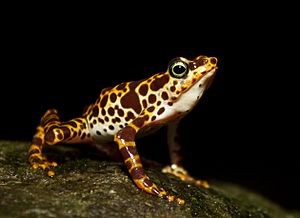Harlequin frogs facts for kids
Quick facts for kids Atelopus |
|
|---|---|
 |
|
| Male A. certus | |
| Scientific classification | |
| Kingdom: | |
| Phylum: | |
| Class: | |
| Order: | |
| Family: | |
| Genus: |
Atelopus
Duméril and Bibron, 1841
|
| Species | |
|
See text. |
|
| Synonyms | |
|
Ateleopus Agassiz, 1846 (unjustified emendation) |
|
Atelopus, often called harlequin frogs, is a large group of true toads. These amazing amphibians live in Central and South America. Their home stretches from Costa Rica in the north to Bolivia in the south.
Harlequin frogs are small and usually have very bright colors. They are also active during the day. Most species prefer to live near cool streams in mid- to high-up areas. Sadly, many species are now in danger of disappearing forever. Some have already become extinct. The main reason for this decline is a tiny fungus called Batrachochytrium dendrobatidis. This fungus causes a disease that is very harmful to frogs.
Even with these challenges, new Atelopus species are still being found. Scientists have described many new kinds in recent years. This shows there is still much to learn about these unique frogs.
Contents
What Are Harlequin Frogs?
Harlequin frogs belong to the family of true toads. They are known for their striking colors. These colors often include bright yellows, oranges, reds, and even blues. Such bright colors can warn predators that the frog might be poisonous.
Where Do Harlequin Frogs Live?
These frogs are found only in the Americas. They live in diverse habitats. You can find them in rainforests, cloud forests, and even high mountain areas. They usually stay close to clean, flowing water. This is because they need streams for breeding and for their tadpoles to grow.
Why Are Harlequin Frogs Important?
Harlequin frogs play a role in their ecosystems. They eat small insects, helping to control insect populations. They also serve as food for other animals. Their bright colors make them unique. They are a sign of healthy environments.
Harlequin Frogs and Their Survival
Many harlequin frog species are facing serious threats. Their numbers have dropped quickly in recent decades. This is a big concern for scientists and conservationists.
The Chytrid Fungus Threat
The biggest danger to harlequin frogs is a disease. It is caused by the chytrid fungus. This fungus attacks the frog's skin. It makes it hard for the frog to breathe and absorb water. This disease has wiped out entire populations of frogs. It has spread rapidly across their habitats.
Other Dangers to Harlequin Frogs
Besides the fungus, harlequin frogs face other problems.
- Habitat loss: Forests are being cut down for farming or building. This destroys the places where frogs live.
- Climate change: Changes in weather patterns can affect their habitats. It can also make them more vulnerable to diseases.
- Pollution: Chemicals from farms or industries can harm streams. This makes the water unsafe for frogs.
Efforts to Protect Harlequin Frogs
Scientists and conservation groups are working hard to save these frogs. They are trying different methods to help them survive.
- Research: Learning more about the chytrid fungus is key. Scientists are looking for ways to treat or stop the disease.
- Captive breeding: Some frogs are kept in special facilities. Here, they can breed safely away from threats. The goal is to release them back into the wild later.
- Habitat protection: Protecting forests and streams is vital. This ensures frogs have safe places to live.
- Public awareness: Educating people about these frogs helps. It encourages everyone to care about their survival.
Discovering New Species
Even with the challenges, new types of harlequin frogs are still being found. This shows how much biodiversity is still out there. It also highlights the need to protect these areas. Each new discovery helps us understand more about these unique amphibians.

